|

A Guide to the Maths in the Murderous Maths Books
This page is primarily intended for home educators, homeschoolers and anyone else
who is coaching maths on an individual basis.
A message from the author:
When I was first asked to write "Murderous Maths", I only accepted the commission
on condition that I was NOT required to produce any sort of textbook. I always saw
"Murderous Maths" as an excuse to create books that people would choose to read for fun.
My priorities have always been:
- Something funny to read. Each book has a few short stories involving the
characters so there should be a few bits to enjoy even for people who hate maths.
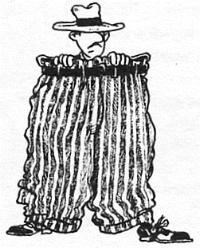 Good amusing illustrations - and I've been very lucky with the artists. In recent
years I've been working very closely with the genius Philip Reeve whose cartoon
strips are hilarious, and yet they can clearly explain some quite complex topics.
Good amusing illustrations - and I've been very lucky with the artists. In recent
years I've been working very closely with the genius Philip Reeve whose cartoon
strips are hilarious, and yet they can clearly explain some quite complex topics.
- Tricks! The joy of maths is that it lends itself to thousands of
tricks - including card tricks, number predictions, or even just quickly checking your
change in a shop.
- Explaining the maths involved as clearly as possible.
Regarding the explanation of maths: I've never been a teacher, and I don't work to any
government imposed curriculum or any KEY STAGE achievement levels. All I try
to do is set out simple instructions as clearly and accurately as possible.
However I've been delighted to receive many messages of
support and thanks from parents and teachers in the UK, the USA and elsewhere, and
that's why this web page was created.
Outlined below is the maths content of each book, so
if you're looking for a new angle to teach or encourage maths, I hope this
will be of help to you!
Many thanks for your interest...
KJARTAN POSKITT
|
Extracts from a message we received:
My 12 year old son is "gifted" yet also dyspraxic.
He spent his primary school years being ostracised because he liked
reading books, hated football and was a mine of useless and useful
information. All this said, he was absolutely shockingly bad at maths.
I was pretty fed up with his school who had written him off as willful
and not worth pushing for the scholarship exams coming up - they had
decided that because his maths was chronic, he wouldn't pass any of
them.
I started tutoring him in maths at home, but it was like a scene
from the exorcist most of the time
(i.e. my head spinning, not his) - and then
I stumbled on the
Murderous Maths Books. Through them he taught
himself maths and thanks to you, became quite an expert. His
defining moment was when he showed his teacher how to multiply mixed
fractions. This was the sort of school that had favourites - and only
recommended one child for the grammar school. However we put
our son in and he passed, and the other kid didn't.
I just wanted you to know what a
big difference you made to one child's life. So thank you so much.
Ro Saul, Kent, England.
|
...my 9 year old boy, who groans when I say it is time to do math, is glued to your book this afternoon... Marilyn Just, New Jersey, USA
Further endorsements can be found at the bottom of this page.
|
THE MATHS CONTENT OF THE INDIVIDUAL BOOKS
The first two books each contain
a variety of little unconnected maths topics to create general interest.
Many of the
topics in these first two books are dealt with in much more detail in the further books.
|
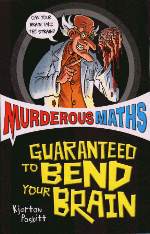 Murderous Maths: Bend Your Brain
Murderous Maths: Bend Your Brain
- A rough guide to the signs: + - x / % and powers
- Tessellation: covering surfaces with shapes.
- Roman Numerals, the development of the "10" and the place system.
- Shortcomings of calculators
- A brief explanation of prime numbers
- Time - how the year and day got divided, digital/analogue clocks
- A brief introduction to angles
- Introducing some real Mathematicians
- Magic squares - how to make your own
- Short cuts, rough mental arithmetic
- A card trick with algebra explanation
- Rounding off long numbers
- Symmetry - reflection and rotation
|
 Murderous Maths: Mash Your Mind
Murderous Maths: Mash Your Mind
- Domino and Pentomino patterns and puzzles
- The difference between length, area and volume, also the difference
between worlds of 1, 2 and 3 dimensions
- Measuring areas and volumes and basic rectangle/triangle formulas
- Speed, calculating and coverting m.p.h. to metres per sec etc.
- Mobius strips
- Pythagoras, right angled triangles, irrational numbers, pi
- Area and perimeter
- Bisecting angles in geometry
- Triangle numbers
- Simple topology networks
- "Mystery" number squares and how to make them.
|
|
The first two books have now been edited together to produce a book suited to younger readers: The Brain-Bending Basics.
Following the success of the first two books, a full series was planned covering
the subject more comprehensively. The next two books explain
all the basic maths you need to understand any other book in the series.
| |

|
|
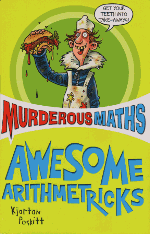 The Awesome Arithmetricks
The Awesome Arithmetricks
- Introduction to numbers, explanation of odd, even and negative numbers
- Signs - just about every sign in maths is explained fully.
- Place value (including decimal places) and rounding off
- Manipulating equations
- ADDITION: adding several big numbers at once, carrying over.
- SUBTRACTION: subtraction big numbers, working out change in shops.
- Time tables, also how to deal with e.g. 700 x 60.
- MULTIPLICATION: e.g. 12834 x 217 without a calculator.
- LONG DIVISION: leading to remainders, simple decimals and fractions
- Estimating answers to big sums
|
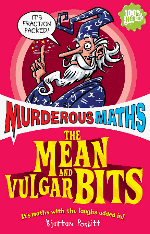 The Mean and Vulgar Bits
The Mean and Vulgar Bits
- Introducing different fractions, converting improper and mixed fractions.
- Multiplying and dividing by vulgar fractions
- Explanation of primes, splitting numbers into prime factors
- Reducing fractions
- Highest Common Factors and Lowest Common Denominators
- Adding and subtracting different fractions
- Egyptian Fractions
- Comparing fractions
- Converting fractions to decimals, decimal place system
- Percentages: increase and decrease
- Averages: calculating means, also modes and medians explained
|
The Awesome Arithmetricks and The Mean and Vulgar Bits have now been edited together to produce a book suited to younger readers: The Secrets of Sums.
Having established the "basics" the rest of the books each follow a separate theme.
| |
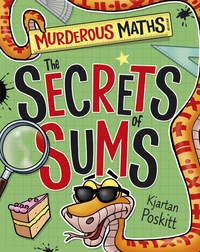
|
|
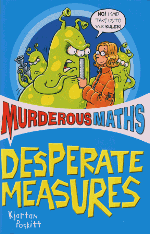 Desperate Measures
Desperate Measures
- Measuring lines - units and accuracy
- Old measuring systems and the development of metric
- The SI system and powers of ten.
- Shadow sticks and trundle wheels
- Names of different shapes
- Measuring areas and area formulas
- What weight really is
- Angles and how to measure them
- Measuring volume, Archimedes Principle
- Density
- Measuring time and how the modern calendar developed.
- Units to measure other things
|
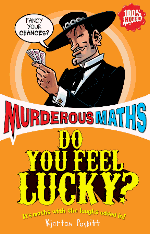 Do You Feel Lucky?
Do You Feel Lucky?
This book deals with probability starting with the very basics, but following
the subject well past the confines of the usual school curriculum.
- Calculating chances on anything including tossing coins,
throwing dice, dealing card hands and sharing birthdays
- Tree diagrams
- Mutually Exclusive and Independent chances
- Pascal's Triangle
- Permutations and Combinations
- Sampling
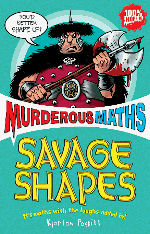 Savage Shapes
Savage Shapes
This is the pure geometry book which has no sums!
- Signs in geometric diagrams
- Loci explained
- Constructions: perpendicular bisectors, dropping perpendiculars,
bisecting angles
- Triangles: different types, similar, congruent, equal areas
- Polygons: regular, irregular, angle sizes and construction.
- Tessellations and Penrose Tiles
- Simple origami
- Circles: chord, tangent and angle theorems.
- Regular solids, Euler's formula
- Ellipses, how to construct, eccentricity
- Geometric proof of Pythagoras' Theorem
|
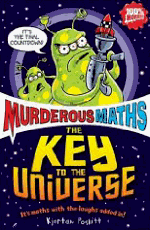 The Key to the Universe
The Key to the Universe
This book is more of a "feature" book rather than an instruction book. It's packed
with facts on numbers that have strange properites.
- Fibonacci Series and the Golden Ratio
- Properties of Square, Triangle, Cube, Centred Hexagon and Tetrahedral numbers
- The "difference of two squares" explained
- Superstitions arising from numbers
- Prime numbers - history including Mersenne primes
- Tests to see if a number will divide by anything between 2 and 13, also 19.
- Finger multiplication
- Binary and base 8 number systems
- Perfect numbers
- Irrational, transcendental and imaginary numbers explained
- The strange properties of infinity
|
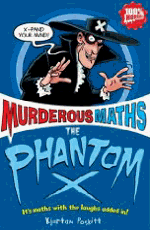 The Phantom X
The Phantom X
This book has just about everything you ever need to know about algebra.
- How letters are used for "unknowns"
- Creating and solving simple linear equations
- Brackets, factorising and expanding (or multiplying out)
- Simplifying expressions
- Solving quadratics and the quadratic formula
- "Think of a number" tricks
- Difference of two squares
- Coefficients of (a-b)n
- Linear graphs, including co-ordinates, gradients, y intercept, solving
simple simultaneous equations
- Other non-linear function graphs including parabolas
- Solving simultaneous equations by substitution or elimination
- The perils of dividing by zero!
|
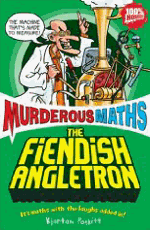 The Fiendish Angletron
The Fiendish Angletron
Here is everything needed to understand Trigonometry including ratios and geometry
- How scales and ratios work on maps and diagrams (plus other ratio examples)
- How to do accurate constructions using a protractor and compasses
- Explanations of the SIN, COS and TAN ratios in right angled triangles
- How to use a calculator to get trig values (both normal and inverse)
- The sin and cosine formulas for non-right-angled triangles
- Measuring far away distances with triangulation
- Measurements in space (including explanations of parallax angles and parsecs)
- Sin/cos/tan relationships
- Drawing a sin wave, and what they sound like
- Bearings - finding positions at sea and plotting a course
|
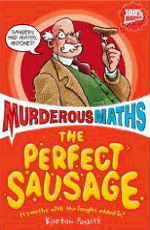 The Perfect Sausage
The Perfect Sausage
An indexed reference book containing about 180 formulas covering just about every topic in maths with explanations. Although presented in the usual Murderous Maths style, it will give additional support for anyone taking exams up to the age 16 level (including GCSE). Formulas include:
- All common areas and volumes, and many unusual ones including ellipsoids and toruses.
- Number formulas (e.g. triangle, hexagonal)
- Speed, acceleration, stopping times and distance
- Force, gravity, range of projectiles
- Money - percentages, simple and compound interest
- Day of the Week Algorithm
- Permutations and Combinations
- Many miscellaneous formulas
See the full index
|
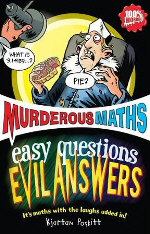 Easy Questions Evil Answers
Easy Questions Evil Answers
A wide range of strange and bizarre bits of maths to satisfy the most curious minds!
Presented in a question and answer format, lots of key maths topics are demonstrated in use including:
- Formulas
- Working out square roots by hand
- π
- Pythagoras
- Paradoxes
- Problem solving
- Metric prefixes
- A guide to massive numbers
- An introduction to vectors
To get a better idea of the complete contents please see the list of questions.
|
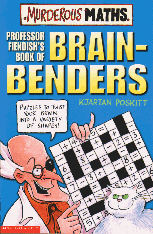 Professor Fiendish's Brainbenders
Professor Fiendish's Brainbenders
Over 100 different challenges, many of which are maths based. Puzzle types include
- mazes
- logic
- coin problems
- number crosswords
- shape cutting/rearranging
- number squares
|
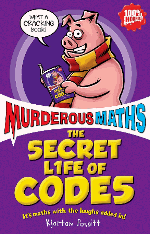 The Secret Life of CODES
The Secret Life of CODES
Everything from basic substitution codes up to the RSA code used for sending credit card details over the internet!
- patterns
- logic and deduction
- prime numbers
- high powers
- MOD function
|
The Murderous Maths of Everything
The first large format full-colour MM book covers a huge range of topics with the focus on FUN!
- Prime numbers
- Sieve of Eratosthenes
- Pythagoras' Theorem
- Triangle numbers
- Square numbers
- The International Date Line
- Geometry (The three problems of antiquity)
- Geometric constructions
- Topology
- Complex Mobius strips
- Curves (including the conic sections and the cycloid)
|
- Golomb Rulers
- 4 dimensional 0's and X's (or "Tic Tac Toe")
- The Golden Ratio
- Fibonacci series
- Equiangular Spirals
- Musical ratios
- Theorems (including Ham Sandwich Theorem and Fixed Point Theorem)
- Probability (cards, dice and other games)
- Pascal's Triangle
- Sierpinski Triangle
- Chess board curiosities
- Light years
- The size and distances of the moon and the planets
- How planets orbit
- The sizes of stars and the shape of the galaxy
|
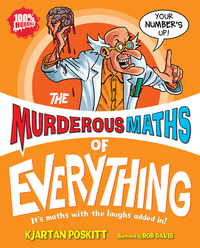
|
|
| |
Teaching math to young homeschool students can be fun when applied to the activities of daily home life. Renovations and
upgrades to a residence
offer multiple opportunities to teach practical money and measuring skills. Students will be able to tackle questions like
what is the cost
of a home elevator? Or how much weight can a
home elevator
hold?
USEFUL LINKS:
WHAT THE PAPERS SAY
Read the Times Educational Supplement
and Primary Times reviews of
"Diabolical Brainbenders"
|
The Complete Book Index
The Online Bookshop
The Full Site Contents at a Glance

Murderous Maths Main Index Page
My boys dropped everything and are ravenously devouring the words written on the pages - my 9 year old boy, who groans when I say it is time to do math, is glued to your book this afternoon.
If I could get them to put the books down I know they would say, "Thanks for making learning so much fun!" Or, more likely, "Dude, your books are funny." Either way it means the same thing!
Marilyn Just, New Jersey, USA
|
I am a homeschooling mother of 5 in Wahoo,Nebraska.
I heard about Murderous Maths from my Math-U-See group.
This is the math curriculum I use.
I am always looking for good, fun math to supplement my children's learning.
Thanks,
Robin Schneider
|
We're ex-pat brits in California (San Jose) and
we heard about MM from our relatives in the UK.
We bought a couple of the books and found that
they were read several times by our children.
They enjoy the jokes and even pick up a bit on the maths.
We haven't found anything similar in the US - a
combination of humour and real maths.
Perhaps its because a lot of maths in the US is merely
rote learning, and performing hundreds of boring
calculations at speed. Anyway, whatever it is,
MM seems to fill a need with our family.
Thanks for the great books.
Toby Ferguson
|
We're a British family living in USA with 2 children - and we find the maths
teaching and the maths text books here REALLY boring - so we have enjoyed
Murderous Maths books which we found on a trip back to UK recently.
We are
now trying to encourage our maths teachers at school to break out of the
tedium and have some fun with maths!
The Smith family, Alabama
|
I'm a math & science teacher in secondary schools in the
neighbourhood of Rome and my wife is a researcher at the
National Institute of Health.
We both found your books interesting , exhilarant , rich
in tips and very appropriate to link pupils to the
usually very boring and tiring activitities connected with maths.
Best regards,
Enrico & Milena Marchiori
|
|
 Good amusing illustrations - and I've been very lucky with the artists. In recent
years I've been working very closely with the genius Philip Reeve whose cartoon
strips are hilarious, and yet they can clearly explain some quite complex topics.
Good amusing illustrations - and I've been very lucky with the artists. In recent
years I've been working very closely with the genius Philip Reeve whose cartoon
strips are hilarious, and yet they can clearly explain some quite complex topics.
 The Key to the Universe
The Key to the Universe
 The Phantom X
The Phantom X
 The Fiendish Angletron
The Fiendish Angletron
 The Perfect Sausage
The Perfect Sausage
 Easy Questions Evil Answers
Easy Questions Evil Answers
 Professor Fiendish's Brainbenders
Professor Fiendish's Brainbenders
 The Secret Life of CODES
The Secret Life of CODES












